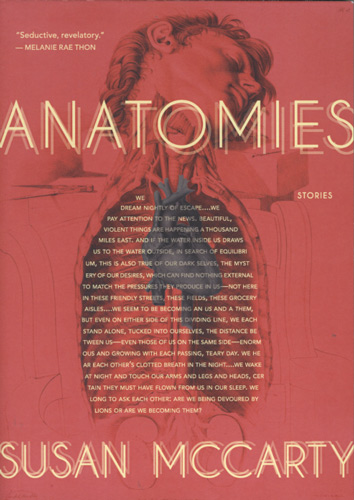Anatomies
If bodies are temples, Susan McCarty is an expert demolitionist. In Anatomies, McCarty breaks these temples down, rips through drywall and flesh, tears sexuality and humanity from their hinges, and leaves behind the barebones, the nervous system, the warm, buzzing electrical impulses buried beneath the exteriors of the temples housing her characters. If bodies are temples, Susan McCarty is an expert demolitionist. In Anatomies, McCarty breaks these temples down, rips through drywall and flesh, tears sexuality and humanity from their hinges, and leaves behind the barebones, the nervous system, the warm, buzzing electrical impulses buried beneath the exteriors of the temples housing her characters.
The images included in this collection work hand-in-hand with McCarty’s mastering of language and breaking-down of body: 1600s medical illustrations by Gerard de Lairesse, all thoughtfully paired with each story. “Another Zombie Story” is paired with severed heads, the skin peeled back to expose brain. A fetus in a split open torso, uterus exposed, is poised across from “The Good Son.” With these bodies splayed open, one almost has the urge to wince, to turn away, and McCarty’s stories produce the same effect: a jarring, raw, realness that begs readers not to look away while simultaneously creating that stomach-squirming feeling of an incoming cringe.
One story dredging up this feeling more than the others is “Kindness.” In this piece, our narrator Tom is a gigolo, but not your average gigolo. His clientele all seek to have their most violent fantasies fulfilled. When fantasy carries over into reality, Tom’s relationship with his girlfriend Maggie is affected in ways he never expected. Even if readers think they know what’s in store, the ending still imparts a sinking feeling and I was grateful for the blank page between this story and the next, a small moment of relief after an emotional barrage.
While there are these moments of quiet relief in Anatomies, they don’t last long. In “Indirect Object,” an ACT tutor is corralled into the grief of a dead student’s family; in “Shearing Day,” teenage boys grapple with the variances in their burgeoning masculinity after heart transplants, one’s machismo giving way to catastrophic consequences; and in “Fellowship,” a teen girl plunges into her sexuality for the summer while her parents’ relationship fails. Each of these stories if full of tension and vulnerability, absorbing readers before pulling the rug out from under them. Reading McCarty’s collection creates caution in the reader: we know we’re going to be hit in the face with raw emotion somewhere within each story. We know the tension will become too much and the moment will snap, but we still can’t force ourselves to look away.
McCarty is inventive, and never formulaic. Even the stories we think we’ve heard before are given a new twist, like in “Field Reports.” A drunken hook-up is turned into—you guessed it—a field report:
Blood alcohol levels:
X: .07
Y: .05Setting
Bar: Red-shadowed, hung with ghosts of smoked cigarettes
No longer hazy but retaining a memory of haze
Table: Tippy, salted, black
Chairs: Ripped and titled toward each otherCostuming
X: Polyester wrap dress: black
Heels: blister-raising, spine-arching
Some Spanx™ shaping undergarments present
Y: Jeans: designer
Dress shirt: untucked, roll-sleeved, lavender
“Anamnesis: An Epilogue” takes a similar route, a character study (perhaps of McCarty herself) turned almost sterile, as if read from a medical chart.
Anatomies is not a collection for the reader who doesn’t want to get their hands dirty. McCarty invites us to pick up a sledgehammer alongside her and give it a swing—to break down the walls of her characters while tunneling through our own deconstructed temples where we might find the things we’ve hidden or forgotten in ourselves. So go get your hands dirty, reader. Break your temple down.





